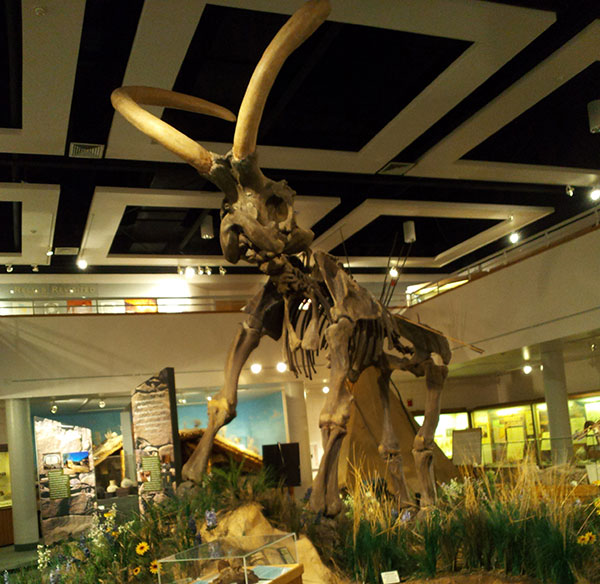Columbian Mammoth (Huntington Mammoth)

Columbian Mammoth
Scientific Name: Mammuthus columbi
Time Period: 1 million to 10,000 years ago, Middle to Late Pleistocene
This magnificent animal was discovered in 1988 in the Manti La-Sal National Forest, and is a hairless Columbian Mammoth. The big bull was approximately 15 feet tall and looked a lot like a modern elephant. He was about 60 years old when he died, probably at the edge of a receding mountain lake between 11,500 and 9,500 years ago. His last meal included needles and twigs from a fir tree, sedge leaves and seeds, and possibly oak and maple.
It was discovered quite by accident by dozer operator Chris Nielson of Huntington, Utah based Nielson Construction. Nielson was working on Huntington Reservoir Dam on the Wasatch Plateau in central Utah, when on August 8, 1988, Mr. Nielson uncovered what was later found to be the front leg bone or the humerus, and a section of the tusk. Much to the delight of everyone concerned, the skeleton was 90% complete.
He was excavated by Utah State Paleontologist Dr. David Gillette, Utah State Archaeologist Dr. David Madsen, and members of the Castle Valley Archaeological Society. Nearby were the remains of an extinct short-faced bear, spruce trees, sagebrush and sedges, and several projectile points. He may have been hunted or scavenged by Paleoindian hunters.
It is believed that this mammoth lived about 10,500 years ago, a time approaching that when mammoths were believed to have become extinct. The site where the Huntington Mammoth was discovered was on August 8, 1988 at an elevation of approximately 9,000 feet, which at the time was the highest elevation of any mammoth find. Since the discovery of this particular mammoth, remains were found in Colorado at an elevation of approximately 10,000 feet.
Tooth condition and the presence of arthritis in this mammoth indicate that it is a very old one. Mammoths, like modern elephants, can enjoy long lifespans, but due to their unique style of tooth replacement, can come under severe stress when their last teeth are worn flat – almost the case with this animal. Casts of this mammoth can be seen at many locations, but the College of Eastern Utah Prehistoric Museum, being an accredited museum as well as a state and federal repository has the original bones. The outstanding preservation will allow much continued study, especially in the realms of organic preservation and even perhaps DNA analysis.
A plains dwelling Columbian mammoth, it had short gray hair similar to to a modern elephant. The mammoth became trapped in a muddy bog and died soon after. The bones were preserved in ice cold mud for 11,500 years. 98% of the specimen was recovered by museum officials and volunteers working with Manti-Lasal National Forest employees, Huntington irrigation company, and the Archaeologists division of Utah State History. This is a life-sized reproduction. The bones are in a special storage area to protect them because they were not fossilized.

